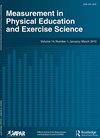体育教育量表的编制与初步验证
IF 1.9
4区 教育学
Q2 EDUCATION & EDUCATIONAL RESEARCH
Measurement in Physical Education and Exercise Science
Pub Date : 2021-06-30
DOI:10.1080/1091367X.2021.1948415
引用次数: 3
摘要
摘要:本研究开发了体育教育量表,并对其进行了心理测量学测试,该量表用于衡量学生对体育教育季节结构特征的看法。在第一个研究中(N = 277名学生),开发了28个项目的库,并进行探索性因素分析,发现了7个因素的解决方案。在第二项研究中(N = 656名学生),通过验证性因子分析验证了28项7因素相关模型,该模型在性别和年龄之间是不变的。选取合适的平均方差提取值满足收敛效度。判别效度以异性状-单性状相关比和潜在因素间相关系数的适宜值为基础。体育教育量表各因子信度均良好。结构方程模型显示,体育教育正向预测学生的感知能力、运动员人格和内在动机。体育教育量表是评估这种教学模式的核心要素的有效和可靠的工具。本文章由计算机程序翻译,如有差异,请以英文原文为准。
Development and Initial Validation of the Sport Education Scale
ABSTRACT This research developed and psychometrically tested the Sport Education Scale, a measure of students’ perceptions of the structural features of a Sport Education season. In the first study (N = 277 students), a pool of 28 items was developed, and an exploratory factor analysis found a 7-factor solution. In the second study (N = 656 students), a confirmatory factor analysis verified the 28-item 7-factor correlated model, which was invariant across gender and age. Convergent validity was met by suitable average variance extracted values. Discriminant validity was underpinned by appropriate values for heterotrait-monotrait ratio of correlations and correlations among latent factors. Reliability was adequate for each factor of the Sport Education Scale. A structural equation modeling showed that Sport Education positively predicted perceived competence, sportspersonship, and intrinsic motivation among students. The Sport Education Scale is a valid and reliable instrument to assess the core elements of this pedagogical model.
求助全文
通过发布文献求助,成功后即可免费获取论文全文。
去求助
来源期刊

Measurement in Physical Education and Exercise Science
Medicine-Orthopedics and Sports Medicine
CiteScore
4.20
自引率
33.30%
发文量
24
期刊介绍:
The scope of Measurement in Physical Education and Exercise Science (MPEES) covers original measurement research, special issues, and tutorials within six substantive disciplines of physical education and exercise science. Six of the seven sections of MPEES define the substantive disciplines within the purview of the original research to be published in the journal: Exercise Science, Physical Activity, Physical Education Pedagogy, Psychology, Research Methodology and Statistics, and Sport Management and Administration. The seventh section of MPEES, Tutorial and Teacher’s Toolbox, serves to provide an outlet for review and/or didactic manuscripts to be published in the journal. Special issues provide an avenue for a coherent set of manuscripts (e.g., four to five) to collectively focus in-depth on an important and timely measurement-related issue within the scope of MPEES. The primary aim of MPEES is to publish high-impact manuscripts, most of which will focus on original research, that fit within the scope of the journal.
 求助内容:
求助内容: 应助结果提醒方式:
应助结果提醒方式:


